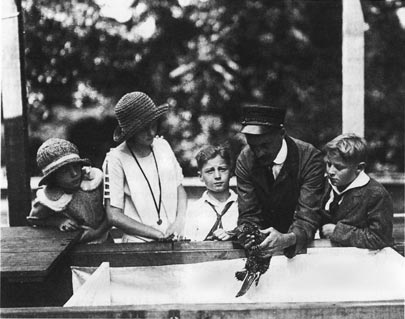
This Article From Issue
March-April 2003
Volume 91, Number 2
DOI: 10.1511/2003.12.0
Animal Attractions: Nature on Display in American Zoos. Elizabeth Hanson. xii + 243 pp. Princeton University Press, 2002. $29.95.
Modern zoos can trace their genealogy back a very long way. Ancient monarchs maintained grand collections of live exotic animals for purposes of private entertainment and public display, and their humble subjects could admire similar specimens in sideshow displays or in pitched arena combats. As this range of viewing opportunities suggests, some branches of this large and venerable family tree have always been more dignified than others. Medieval and early modern Europe offered a similar spectrum of proto-zoos, from the private menageries of kings and wealthy aristocrats to the street performances and tavern displays of mangy individual specimens.

From Animal Attractions.
The first recognizably modern zoos emerged in the 18th century, and the 19th century saw the foundation of many of our most distinguished contemporary zoological gardens, as well as of many less successful institutions that linger now only in memory, if at all. That profusion of new zoos can be accounted for in several ways. Improvements in transportation meant that increasing numbers of exotic animals arrived alive on the docks of Europe and North America, although many more arrived dead, to be stuffed and displayed in natural history museums. Improvements in the political and material infrastructure of imperialism meant that Western adventurers, administrators and businessmen had access to the natural products of hitherto unexploited regions. Zoological science was at the cutting edge; researchers observed the behavior of zoo animals while they lived and dissected them after they died. Natural history in all its forms (living or dead; dried, stuffed or bottled) was popular, as were exotic spectacles more generally.
In Animal Attractions, Elizabeth Hanson focuses on the public zoos established in American cities, beginning with Philadelphia in 1874 and Cincinnati in 1875. Although she concludes her story with current worries about biodiversity and animal rights, the bulk of the book deals with the period before 1940, by which time zoos had been established in more than 100 American cities. Hanson understands these zoos both as expressions of civic pride—that is, more democratic versions of the impulse that drove kings to collect lions and elephants—and as instruments of civic virtue. She persuasively demonstrates their connection with the public parks movement, a response to late-19th-century fears about the decay of both moral and bodily health in urban environments. The large green spaces that many cities established in response to such fears were obvious places to locate collections of wild animals, not just because zoos required a lot of room, but because both wild animals and large urban parks were strongly (if problematically) associated with nature.
Using a wealth of examples, in which the experiences of the National Zoo in Washington, the Bronx Zoo and the Philadelphia Zoo figure with particular prominence, Hanson also discusses the development of modern standards of wild animal husbandry, changing fashions in zoo architecture and the often brutal and wasteful process by which the market for wild animals was supplied. Although she is primarily concerned with the development of zoos as institutions, she also describes some very interesting characters, such as animal collector and self-publicist Frank Buck and taxidermist-turned-zoo-director William Hornaday.
Hanson has collected a great deal of fascinating information about the history of American zoos. The book might have been more fascinating still had she been more open to considering ways in which the zoos she has so thoroughly researched transcend her characterization of them. For example, she is inclined to overstate the extent to which they are distinctively American, even while acknowledging that they participated in an international circulation of animals and tended to follow the lead of major European zoos. She accepts too readily the equation of captive animals with nature. And she is reluctant to acknowledge that zoo displays, which are intended to be uplifting and educational, had—and continue to have—much in common with commercial menageries, circuses and even freak shows. There is an essential paradox involved in looking at wild animals confined in cages; zoo animals have entered a borderline state, being neither wild nor tamed. But Hanson has defined her topic to exclude any exploration of that liminality, even though it may be the most interesting thing about zoos.—Harriet Ritvo, History, Massachusetts Institute of Technology
American Scientist Comments and Discussion
To discuss our articles or comment on them, please share them and tag American Scientist on social media platforms. Here are links to our profiles on Twitter, Facebook, and LinkedIn.
If we re-share your post, we will moderate comments/discussion following our comments policy.